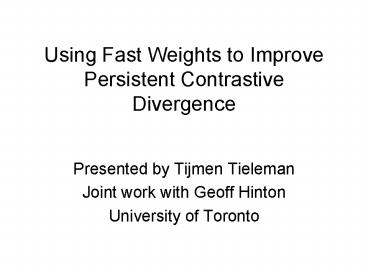Using Fast Weights to Improve Persistent Contrastive Divergence - PowerPoint PPT Presentation
Title:
Using Fast Weights to Improve Persistent Contrastive Divergence
Description:
Using Fast Weights to Improve Persistent Contrastive Divergence Presented by Tijmen Tieleman Joint work with Geoff Hinton University of Toronto – PowerPoint PPT presentation
Number of Views:106
Avg rating:3.0/5.0
Title: Using Fast Weights to Improve Persistent Contrastive Divergence
1
Using Fast Weights to Improve Persistent
Contrastive Divergence
- Presented by Tijmen Tieleman
- Joint work with Geoff Hinton
- University of Toronto
2
What this is about
- An algorithm for unsupervised learning modeling
data density. Not classification or regression. - Using Markov Random Fields
- Also known as
- Energy-based models
- Log-linear models
- Products of experts, or product models
- Such as Restricted Boltzmann Machines
3
MRF Learning
- Increase probability where training data is
- Decrease probability when the model assigns much
probability - Problem finding those places (sampling) is
intractable - CD or PL use surrogate samples, a few steps away
from the training data. - It works ? Best application paper etc
- But its not perfect
4
The problem with CD
5
The problem with CD
6
PCD (part 1)
- Gradient descent is iterative.
- We can reuse data from the previous gradient
estimate. - Use a Markov Chain for getting samples.
- Plan keep the Markov Chain close to equilibrium.
- Do a few transitions after each weight update.
- Thus the Chain catches up after the model
changes. - Do not reset the Markov Chain after a weight
update (hence Persistent CD). - Thus we always have samples from very close to
the model.
7
PCD (part 2)
- If we would not change the model at all, we would
have exact samples (after burn-in). It would be a
regular Markov Chain. - The model changes slightly,
- So the Markov Chain is always a little behind.
8
PCD Pseudocode
- Initialize 100 Markov Chains, negData,
arbitrarily - Initialize the model, theta, with small random
weights - Repeat
- Get positive gradient on a batch of training data
- Get negative gradient on negData.
- Do learning on theta using the difference of
gradients. - Update negData using a Gibbs update on the
current model.
9
Lets take a step back
- Gradient descent is iterative.
- We can reuse data from the previous estimate.
- Use a Markov Chain for getting samples.
- Plan keep the Markov Chain close to equilibrium.
- Do a few transitions after each weight update.
- Thus the Chain catches up after the model
changes. - Do not reset the Markov Chain after a weight
update (hence Persistent CD). - Thus we always have samples from very close to
the model.
10
Really?
- Gradient descent is iterative.
- We can reuse data from the previous estimate.
- Use a Markov Chain for getting samples.
- Plan keep the Markov Chain close to equilibrium.
- Do a few transitions after each weight update.
- Thus the Chain catches up after the model
changes. - Do not reset the Markov Chain after a weight
update (hence Persistent CD). - Thus we always have samples from very close to
the model.
11
The mixing rate
- Markov Chain (i.e. PCD with learning rate 0)
12
The mixing rate
- Learning rate 0.00003
13
The mixing rate
- Learning rate 0.0001
14
The mixing rate
- Learning rate 0.0003
15
The mixing rate
- Learning rate 1
16
The mixing rate
- Learning rate 3
17
The mixing rate
- Learning rate 10
18
Learning accelerates mixing
- Negative phase wherever negData is, reduce
probability (do unlearning) - Suddenly, those negData Markov Chains are in a
low probability area - Therefore, they quickly move away, to a higher
probability area - Repeat repeat
- Similar but deterministic Herding Dynamical
Weights to Learn by Max Welling (poster today)
19
New idea
- Learning makes the chain mix
- Faster learning makes the chain mix faster
- but going too fast will mess up the learning
- Keep separate fast weights that learn rapidly
- Keep them close to the regular weights
- The chains mix using the fast weights
- The chains provide good samples for learning
- On the regular weights, the learning rate is
small.
20
FPCD Pseudocode
- Initialization
- regular theta small random weights.
- fast theta all zeros.
- Initialize negData arbitrarily.
- Repeat
- Get the positive gradient on a batch of training
data. - Get the negative gradient on negData.
- Do learning on both regular theta and fast theta
using the difference of gradients (but with
different LRs). - Update negData using a Gibbs update, with
parameters regular theta fast theta. - Update fast theta ? fast theta 0.95
21
Additional notes
- When fast theta is all zeros, FPCD PCD.
- There should be different learning rates for
regular theta and fast theta. - Regular theta must learn slowly, to prevent
getting bad models. - Fast theta must learn rapidly, to enable fast
mixing.
22
Results
- FPCD helps a lot
- when not many updates can be done (i.e. large
data dimensionality). - For small models (e.g. toy) with lots of training
time ? same as PCD. - More results poster.
23
Conclusion
- FPCD Fast PCD Persistent Contrastive
Divergence using Fast weights - Use fast learning-causing-mixing, but not on the
regular model parameters.
24
The End
25
The mixing rate
- Markov Chain (i.e. PCD with learning rate 0)































